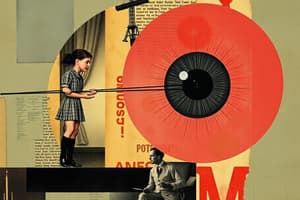Podcast
Questions and Answers
What is indicated by bitemporal hemianopia in a patient during the reading confrontation test?
What is indicated by bitemporal hemianopia in a patient during the reading confrontation test?
- The patient fails to count fingers in the nasal quadrants of both eyes.
- The patient counts fingers in all quadrants.
- The patient fails to count fingers in the temporal quadrants of each eye. (correct)
- The patient counts fingers only in the nasal quadrants.
What procedure is generally followed in the reading confrontation test?
What procedure is generally followed in the reading confrontation test?
- The patient is positioned to the side of the examiner to assess peripheral vision.
- The patient is asked to read letters from a distance.
- The examiner holds up fingers for the patient to count in different visual field locations. (correct)
- The clinician uses a physical instrument to measure vision.
What result indicates a normal reading confrontation test?
What result indicates a normal reading confrontation test?
- The patient fails to respond in the temporal quadrant of one eye.
- The patient counts fingers in all quadrants of both eyes. (correct)
- The patient only sees fingers in one quadrant.
- The patient reports seeing nothing in any quadrant.
In which scenario is homonymous hemianopia indicated during the test?
In which scenario is homonymous hemianopia indicated during the test?
What does the reading confrontation test primarily assess?
What does the reading confrontation test primarily assess?
What is a necessary step in the protocol of the reading confrontation test?
What is a necessary step in the protocol of the reading confrontation test?
What type of visual defect is assessed by counting the fingers in the reading confrontation test?
What type of visual defect is assessed by counting the fingers in the reading confrontation test?
Which of the following accurately describes the instrument used in the reading confrontation test?
Which of the following accurately describes the instrument used in the reading confrontation test?
During the reading confrontation test, how should the patient respond?
During the reading confrontation test, how should the patient respond?
What result does a patient with normal vision achieve during the reading confrontation test?
What result does a patient with normal vision achieve during the reading confrontation test?
Study Notes
Reading Confrontation Test
- A test used to measure visual field defects.
- Bitemporal hemianopia: The patient cannot see objects in the outer (temporal) half of both eyes.
- Homonymous hemianopia: The patient cannot see objects in one outer (temporal) half of one eye, and one inner (nasal) half of the other eye.
- Normal result: The patient can see objects in all quadrants of both eyes.
- The test is performed by having a patient identify the examiner's fingers as they are presented in different locations within the patient's visual field.
- The examiner presents fingers in different quadrants of both eyes, typically in a grid-like pattern.
- Positions: The examiner presents fingers in the upper, lower, inner, and outer quadrants of the patient's visual field.
- Patient Response: The patient indicates whether or not they see the examiner's fingers.
- The results of the test are documented for each quadrant of each eye, noting whether the patient could see the fingers or not.
- This test is used to detect visual field defects related to various conditions affecting the visual pathways.
Studying That Suits You
Use AI to generate personalized quizzes and flashcards to suit your learning preferences.
Description
This quiz covers the Reading Confrontation Test, a method to measure visual field defects in patients. It explains conditions such as bitemporal and homonymous hemianopia, as well as the procedure for assessing visual fields. Participants will learn about the test's positions, patient responses, and documentation of results.




